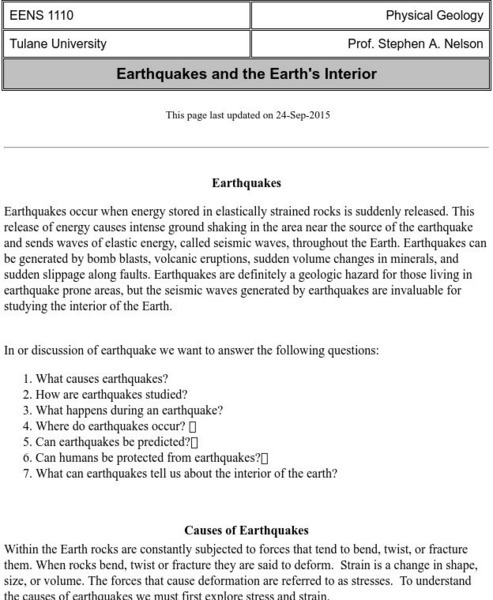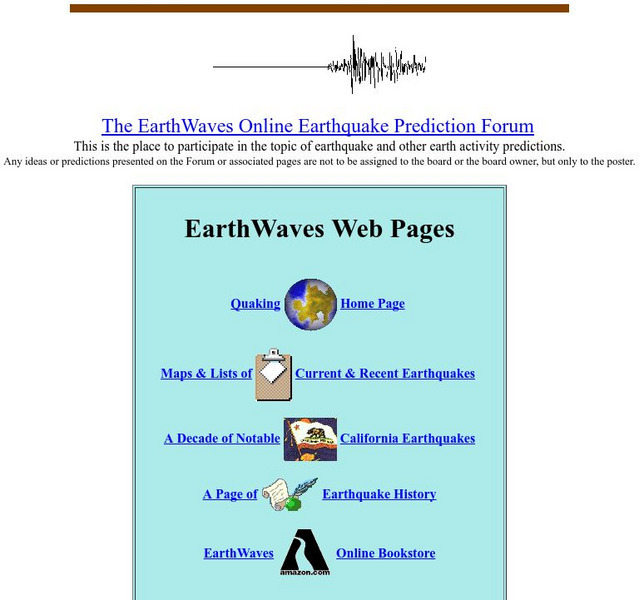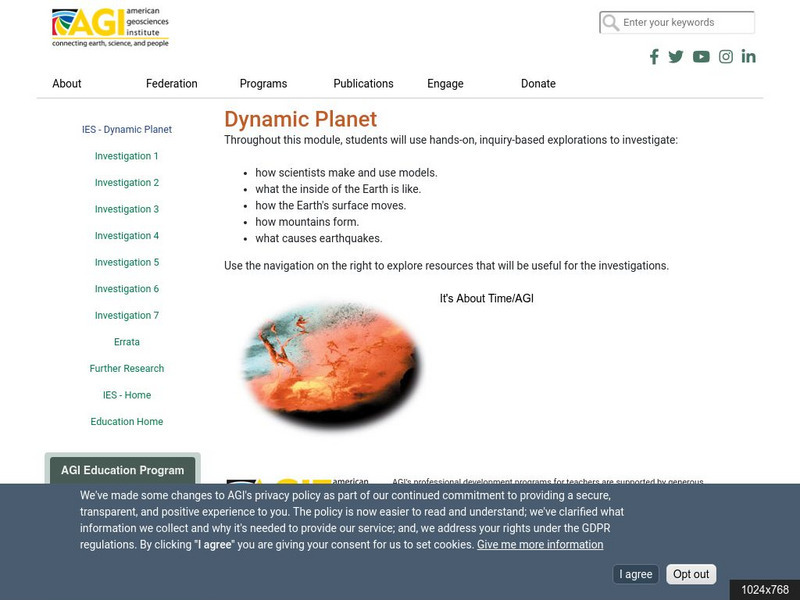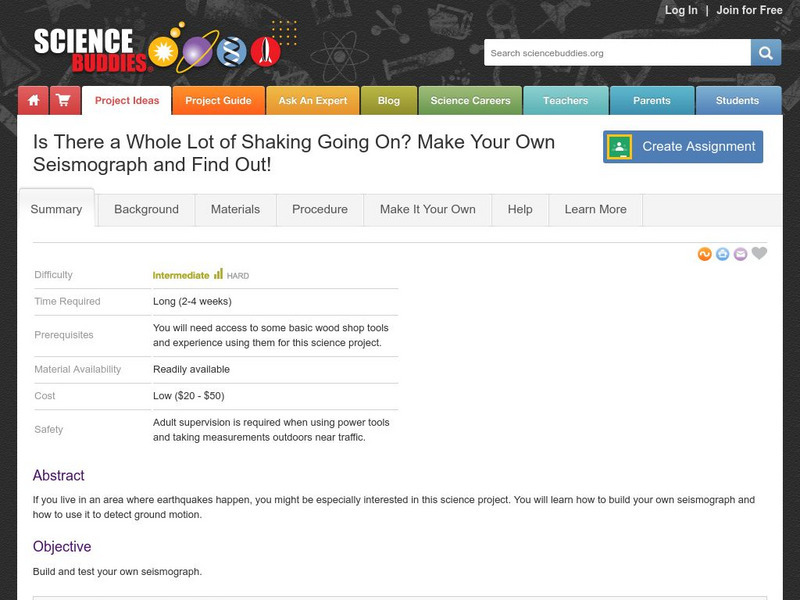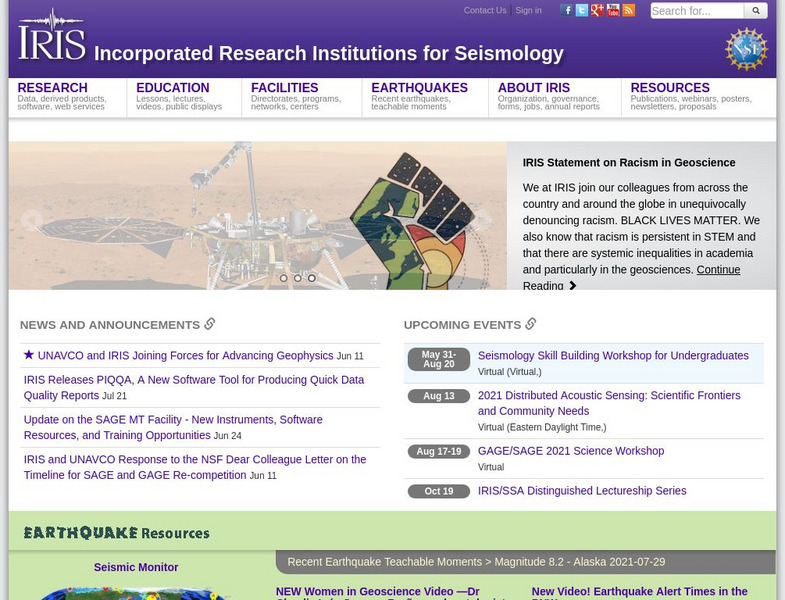Hi, what do you want to do?
CK-12 Foundation
Ck 12: Earth Science: Seismic Waves Study Guide
[Free Registration/Login may be required to access all resource tools.] This study guide summarizes key points about types of seismic waves. Includes a few questions to check for understanding.
Science4Fun
Science4 Fun: Earthquake
Information about earthquakes including causes and how they are measured.
Other
Tulane University: Earthquakes and Earth's Interior
College instructor's notes on seismology includes earthquake origins, seismic waves, risks and damage assessments, and other information about the interior structure of the Earth.
Other
Earth Waves: Our Changing Planet
A compilation of information from volunteers on earthquakes and earthquake prediction. Includes a lot of information on quakes in the California area plus some nice maps.
Other
Ceri: Earthquake Facts and Follies
A list of frequently asked questions about earthquakes. This is a good source for earthquake trivia and separating fact from fiction.
University of Washington
University of Washington: Physics of Tsunamis
The civil engineering department presents the physics of a tsunami. The topics addressed: what does "tsunami" mean; how do tsunamis differ from other water waves; how do earthquakes generate tsunamis; how do landslides, volcanic...
American Geosciences Institute
American Geosciences Institute: Dynamic Planet
Seven hands-on lessons module where students learn about our dynamic planet. These inquiry-based explorations investigate scientific models, earthquakes and seismic waves, Earth's interior, Earth movements, the lithosphere, plate...
PBS
Pbs: Earth Science Exploration
An earth science collection where learners can explore earthquakes, volcanoes, and more natural phenomena. The collection uses videos and interactive activities to investigate our dynamic planet and earth systems.
Concord Consortium
Concord Consortium: Exploring Earth's Seismicity
This sequence is an introduction to plate tectonics using evidence from topographical maps, earthquake location and depth, and volcano location using the Seismic Explorer model to investigate patterns of earthquake data and to infer the...
Science Buddies
Science Buddies: What's All That Shaking? Make Your Own Seismograph!
If you live in an area where earthquakes happen, you might be especially interested in this science project. You'll learn how to build your own seismograph and how to use it to detect ground motion.
Curated OER
P and S Waves
A description of the different types of earthquake waves that features graphics and explanations accompanied by video interview with an expert in the field.
Curated OER
Rayleigh and Love Waves
A description of the different types of earthquake waves that features graphics and explanations accompanied by video interview with an expert in the field.
NOAA
Noaa: International Tsunami Information Center: Tsunami, the Great Waves
National Oceanic and Atmospheric Administration defines a tsunami and links to related pages about what causes tsunamis and how lives can be saved from their devastation.
PBS
Wnet: Thirteen: Savage Earth: Waves of Destruction, a Tsunami Animation
View a brief animation that explains the science behind a tsunami.
Columbia University
Scientific Background on the Indian Ocean Earthquake and Tsunami
This site features information and related links that can be used by students and scientists to understand the events that led to the December 2004 Indian Ocean tsunami.
US Geological Survey
U.s. Geological Survey: Rock'n on Shakey Ground [Pdf]
The basics of earthquake science including factual information about how and why they happen. Also includes some hands-on activities and experiments for students.
PBS
Wave That Shook the World
This resource focuses on the December 26th Indian Ocean tsunami. It explains the anatomy of the Indian Ocean tsunami, as well as what is being done to prepare for future tsunamis. In addition, it shows potential hot spots for future...
Incorporated Research Institutions for Seismology
Iris: Global Seismogram Viewer
Discover the P-wave Shadow Zone and how it can be used to determine the diameter of Earth's outer core.
Michigan Technological University
How Are Earthquake Magnitudes Measured?
This website explains how the Richter and Mercalli Scales work.
Incorporated Research Institutions for Seismology
Iris: Incorporated Research Institutions for Seismology
This university consortium provides on-going, current information on seismic activity happening all over the world. Of special interest is the Seismic Monitor. Open this page to a full screen to monitor global earthquake activity in real...
Discovery Education
Discovery Education: Dynamic Earth, Tsunami
Use this site to teach your students what a tidal wave or tsunami is from this lesson plan. The discovery activity shows how a tsunami happens.
Exploratorium
Exploratorium: Science Snacks: Resonant Rings
An experiment in resonance that demonstrates how the vibrations of an earthquake affect buildings of different sizes and degrees of flexibility.
Incorporated Research Institutions for Seismology
Iris: Seismic Tomography
Using a technique called seismic tomography, scientists decoded the information contained in seismograms' squiggles to develop this image of an individual slice through the deep Earth.
BBC
Bbc: Cbbc Newsround: Asia Earthquake Disaster
Diaries, pictures, guides, quizzes, and news about the Asian tsunami one year after it hit.






